After the completion of block construction, as a rule, there are many stones left, acquired as a reserve. In this case, you can make a brazier from blocks with your own hands in the country and get a practical and functional structure at your disposal. In comparison with purchased stoves, a brazier made of expanded clay concrete blocks or similar materials will cost several times cheaper, but practically not inferior in quality to the preparation of a wide variety of products. With the right approach to business, a homemade barbecue made of blocks will be an excellent decoration of the site.
Overview of basic materials
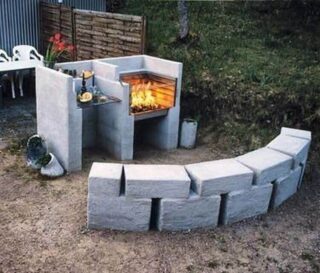
Concrete-based building blocks have long been a serious competitor to traditional bricks, panels and panels. This is explained by the following advantages of the material:
- big size;
- high construction speed;
- relatively low weight, allowing to reduce the foundation, facilitate loading, unloading and masonry process;
- ease of processing (sawing, drilling);
- frost resistance;
- low thermal conductivity;
- applicability for various types of plaster;
- wide assortment on the market;
- affordable cost.
Varieties of blocks:
- Foam blocks. They consist of cement, sand, water and a foaming agent that provides foaming of the mixture. Density varies between 300-900 kg / m³. Shrinkage is negligible, but hygroscopicity is significant. The substance is fragile, waterproofing of surfaces and strengthening of bearing edges is required.
- Gas blocks. A mixture of cement and sand is enriched with gypsum, metallurgical slag and lime. For foaming, aluminum dust is used, which releases hydrogen when interacting with a highly alkaline cement mortar. The best model on the market is considered to be Yutong brand products. The material is durable, but highly absorbent. Do-it-yourself gas block brazier requires high-quality waterproof cladding.
- Cinder block. The composition includes sand, cement and many fillers - slag, ash, shell rock. It is produced in monolithic or hollow version. It is characterized by sufficient strength, thermal conductivity, tendency to absorb water and the development of mold. Requires sanitization and finishing.
If you need to save money, it is better to use a cinder block, provided that there is a protection from the effects of dampness. For long-term use, it is recommended to build an aerated concrete hearth with higher aesthetic and operational characteristics.
Combined brazier projects
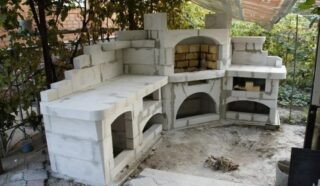
When considering a project for a summer cottage foam concrete barbecue, you should not dwell on the simplest option. The possibilities of such a facility will be limited in terms of the variety of dishes and the volume of their production.
The brazier can be combined with the following options:
- cauldron;
- B-B-Q;
- smokehouse;
- hob;
- drying.
The hearth is perfectly complemented by an arch with a chimney, a sink, a cutting table, shelves and drawers for a wide variety of accessories.
After determining the design, you need to choose the right place for installation. It is impossible to make a mistake here, since it will be impossible to move the stone structure. In addition, in addition to being consistent with the landscape, there are a number of technical issues to consider.
Minimum distances between the barbecue and other objects:
- fence - 1 m;
- tree or bush - 3 m;
- residential building - 5 sq.
There should be a convenient and short passage to the recreation area, the best option is the side of the gazebo farthest from the house. From the side of the street, you can put shields made of vine, polycarbonate or a high hedge.
Construction stages
Construction site arrangement
It is best to conduct construction in the warm season, when the earth has dried out and settled after the winter heaving, and it is still far from frost. The best option for the middle lane is May-September.
To build a brazier from foam blocks with your own hands, you will need the following devices:
- welding;
- Bulgarian;
- shovel;
- level;
- roulette;
- square;
- mixer;
- drill.
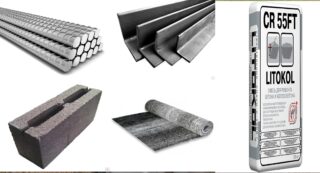
Materials:
- fittings;
- steel corner;
- mix for concrete;
- blocks;
- glue;
- roofing material;
- metal sheet 4-6 mm.
To prevent injury, you need to work with mounting glasses and gloves.
The practical part begins with the preparation of the site. The markup is carried out, a place for the foundation is outlined, the track is traced. Then the grass is mowed, trees are cut down, stumps and bushes are removed. Then communications are brought in, garbage bags are prepared. If necessary, a temporary tent is set up.
Foundation organization
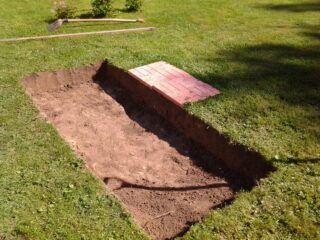
Since the foam blocks are lightweight, a strong base is not required for the finished structure. On dense and stable ground, it is enough to lay out a site of bricks and concrete slabs. If the earth is prone to heaving, this problem needs to be approached more thoroughly.
Step-by-step instructions for arranging the foundation:
- Digging a pit 30 cm deep. Removing plant roots and stones. Bottom alignment and compaction.
- Laying a geotextile cloth in a pit. It will prevent bedding from erosion, grass and shrubs germination.
- Organization of the pillow. First, 15 cm of sand is poured, moistened and leveled. A layer of fine gravel 15 cm high is poured on top.
- Formwork installation. Planks are used, the top of which rises 10 cm above the ground. The edges need to be well aligned to be used as beacons.
- Laying the steel frame. Reinforcement or steel mesh is used. The structure is fixed on spacers.
- Preparation and pouring of concrete. The surface is leveled and covered with a film. When the mixture becomes firm, but somewhat loose, you can grind off sharp corners to avoid chipping and injury.
Depending on the temperature, it will take 7-10 days for the slab to cure.
BBQ laying
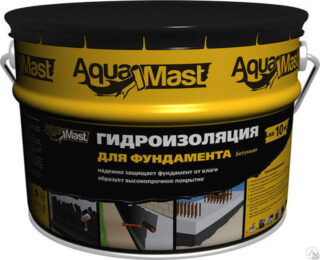
When the concrete is completely solidified, you can continue to work.
The sequence of laying the stove:
- Removing the formwork. Laying waterproofing in the form of mastic or roofing material.
- Laying 2-3 rows of stones in the shape of the letter "P". A corner and rods or a steel plate with holes are laid on top of the blocks. This is the grate.
- Removing two more rows. This is how the firebox is formed.
- Finishing, as the foam blocks are not designed to come into contact with fire. Fireclay bricks are glued from the inside, and ceramic tiles are glued outside.
- Manufacturing and laying on the surface of an iron frame from a corner or channel. It will be the basis for skewers, grates or hobs.
For a metal top, it's best to use stainless steel so you don't have to fight rust all the time.
Joining seams
A mixture of chamotte clay, sand and cement should be used as a binder solution for masonry. Such a composition perfectly tolerates strong heat and low temperatures.The leveling of the solution is carried out immediately after the completion of the next row, until the solidification process has begun. Joining is carried out flush with the surface or curly grout, giving the seams a semicircular profile. The choice depends on the tastes of the owners.
Weather protection
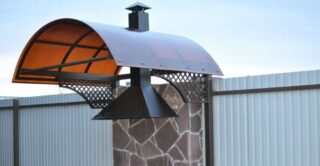
The brazier can quickly deteriorate from water, wind and ultraviolet radiation. To protect against external factors, you can make a hinged cover or build a canopy with a chimney. For the period of absence, it is recommended to cover the barbecue with a tarpaulin or plastic cover. In humid areas, raise the foundation higher.
Decorative finishing increases the degree of protection and makes the grill more beautiful. You can decorate the structure with facade plaster, pebbles, pieces of glass, beads, artificial stone, clinker. The choice is dictated by the configuration of the building and the style of the site.









